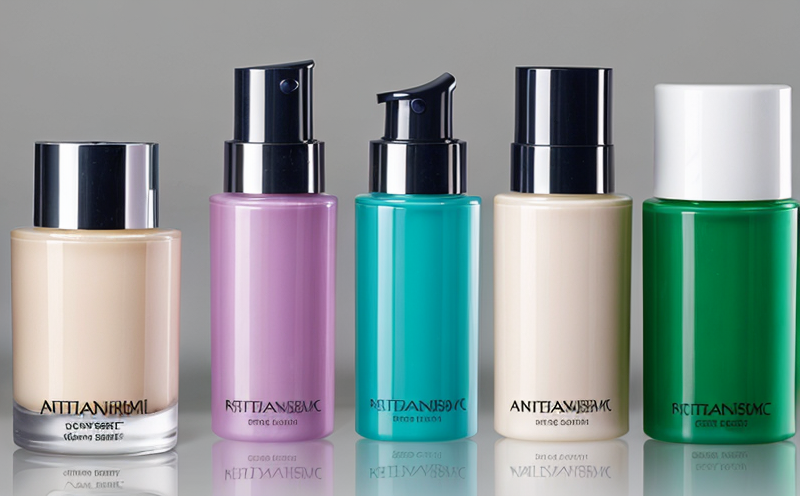Preservative Safety and Efficacy Testing in Cosmetics
The safety and efficacy of preservatives in cosmetics are critical considerations due to their role in preventing contamination and maintaining product quality. Preservatives, such as parabens, benzyl alcohol, and quats, are used to inhibit the growth of microorganisms like bacteria, fungi, and yeasts that can cause spoilage or pose health risks.
Testing for preservative efficacy ensures that cosmetic products meet safety standards set by regulatory bodies globally. For instance, the ISO 21778 standard outlines procedures for determining the effectiveness of antimicrobial preservatives in cosmetics.
The primary goal is to ensure that preservatives do not compromise product safety or cause adverse reactions when used as directed. This involves both in vitro and in vivo testing methods, which can vary based on the type of cosmetic formulation being tested—creams, lotions, shampoos, etc.
For creams and lotions, a ASTM F2680 test might be used to evaluate preservative efficacy against a range of microorganisms. This involves inoculating the product with specific strains of bacteria or fungi, then incubating it under controlled conditions to observe growth.
In vivo testing may also involve patch tests on human subjects to monitor for allergic reactions after prolonged exposure to the cosmetic containing the preservative. This ensures that even long-term use of the product is safe and effective.
Testing must be conducted in a laboratory environment that adheres to strict quality control measures, including proper handling of samples, accurate measurement techniques, and adherence to all relevant safety protocols. Compliance officers will find this testing particularly useful for ensuring regulatory compliance with standards like those set by FDA or EU Cosmetics Regulation.
The use of advanced laboratory equipment such as microbiological growth chambers, spectrophotometers for measuring bacterial or fungal colonies, and high-performance liquid chromatography (HPLC) for detecting preservatives ensures accurate results. Quality managers will benefit from understanding these processes, as they ensure that the products they oversee are safe and effective.
Testing for efficacy also involves evaluating the minimum inhibitory concentration (MIC) of a preservative to determine its effectiveness against specific pathogens. This requires precise measurement techniques and is typically conducted in controlled laboratory conditions to ensure accuracy.
The testing process can be complex, involving multiple steps such as sample preparation, inoculation with microorganisms, incubation periods, and subsequent analysis for microbial growth or survival rates. Compliance officers need to understand these processes to oversee the quality of preservative efficacy testing within their organizations.
In summary, preservative safety and efficacy testing are essential components of ensuring that cosmetic products meet both regulatory requirements and consumer expectations. By conducting thorough and accurate tests, laboratories can provide reliable data that supports safe product development and marketing.
Why It Matters
The importance of preservative safety and efficacy cannot be overstated in the cosmetics industry. Consumers expect high-quality products that are both effective and safe to use. Ensuring that preservatives do not compromise this expectation is crucial for maintaining consumer trust.
Ineffective or unsafe preservatives can lead to product spoilage, health risks, and a loss of market share due to recalls or negative publicity. Regulatory bodies like the FDA and EU Cosmetics Regulation have strict guidelines regarding the use and efficacy of preservatives in cosmetics. Compliance with these regulations is mandatory for businesses operating within these jurisdictions.
From a business perspective, ensuring that preservative testing meets all regulatory requirements can prevent costly delays and penalties. It also helps maintain a positive brand image and fosters consumer confidence, which are vital for long-term success.
For quality managers and compliance officers, understanding the significance of these tests is critical. They play a key role in overseeing the implementation of safety protocols and ensuring that all testing aligns with regulatory standards. This not only protects the business but also ensures that consumers receive safe and effective products.
The implications of poor preservative efficacy extend beyond immediate product quality concerns to broader issues affecting public health and trust within the industry. Ensuring that every step of the testing process adheres to high-quality standards is essential for maintaining both consumer safety and brand reputation.
Industry Applications
- Creams: Testing for preservative efficacy in creams ensures they remain free from microbial contamination, thus enhancing their shelf life and user experience.
- Lotions: Lotions require similar testing to ensure that the preservatives used do not compromise product safety or cause adverse reactions when used as directed.
- Shampoos: Shampoos need effective preservatives to prevent fungal and bacterial growth, ensuring that they remain fresh and safe for use.
In addition to these specific applications, the testing of preservative efficacy is crucial across various cosmetic formulations. The goal remains consistent: to ensure that all products are both safe and effective for consumers.
International Acceptance and Recognition
The acceptance and recognition of preservative safety and efficacy testing in cosmetics are largely influenced by international standards and regulations. Compliance with these standards ensures that cosmetic products meet the highest quality and safety requirements, both domestically and internationally.
In the United States, the FDA regulates cosmetics under the Food, Drug, and Cosmetic Act, which requires companies to ensure that their products are safe for use. The agency provides guidelines on testing methods and acceptable preservatives, ensuring that all products meet these standards.
In Europe, the EU Cosmetics Regulation (EC 1272/2006) sets out detailed requirements for cosmetic product safety, including preservative efficacy testing. Compliance with this regulation is mandatory for businesses operating within the European Union. The regulation emphasizes the importance of using appropriate testing methods and reporting accurate results to ensure consumer safety.
Similarly, in Asia, countries like Japan have strict regulations regarding cosmetics that require rigorous testing procedures. Standards such as those set by the Japanese Industrial Standards (JIS) are widely recognized and followed globally.
The acceptance of preservative safety and efficacy testing is not limited to these regions. Laboratories around the world adhere to internationally recognized standards, ensuring that cosmetic products meet the highest quality and safety requirements regardless of their destination market.





